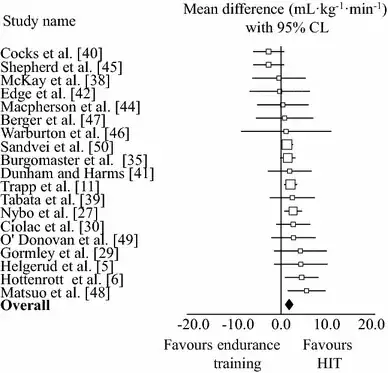This answer looks at the results of three different meta-analyses that look at HIT vs traditional endurance training. The evidence is mixed, but generally supports HIT being slightly better.
Sources linked in the question
The second paper in the question concludes that High Intensity Interval Training (HIIT) for teenagers is better for cardio than not exercising. That is not a huge surprise to anyone; Any form of exercise is better than none. Because it doesn't look at traditional endurance training, it is not really relevant to this question.
The first paper is a meta-analysis that compares how HIIT and continuous endurance training affect maximal oxygen consumption, a measure "of endurance capacity during prolonged exercise." According to this paper, both HIIT and traditional endurance training increase VO2max by about the same amount, but there is a "possibly small beneficial effect" in favor of HIT.
They came to this conclusion by examining the studies that directly compare HIT and traditional endurance training. Four of the 19 studies favor traditional endurance training; The other 15 favor HIT. They found that on average HIT increases VO2max by 1.2 mL/kg/min compared to traditional training. For comparison, both HIT and traditional increase VO2max by about 5 mL/kg/min compared to not exercising, four times the difference between HIT and traditional.

Most of the studies in this diagram have uncertainty intervals that cross the 0 line; Most of them cannot be certain whether HIT or traditional training is better, even if they find an advantage for HIT. The meta-analysis is also careful to not overstate the certainty of their results.
A few months ago, I decided to switch from continuous training to HIT. This evidence is strong enough to convince me to keep doing HIT, but I wouldn't be too surprised if it turned out to be wrong. Science is plagued by statistical shenanigans and bias. Meta-analyses are the best tool for cutting through this, but they are still limited.
The first paper reviews a few other meta-analyses that studied the same topic.
This meta-analysis came to the following conclusion.
HIIT significantly increases Cardio-Respiratory Fitness (CRF) by almost double that of Moderate Intensity Continuous Training (MICT) in patients with lifestyle-induced chronic diseases.
Double is a lot higher than the one quarter seen in the first paper.
This meta-analysis, came to the following conclusion:
Sprint Interval Training (SIT) improves aerobic capacity in healthy, young people. Relative to continuous endurance training of moderate intensity, SIT presents an equally effective alternative with a reduced volume of activity. This evaluation of effects and analysis of moderating variables consolidates the findings of small-sample studies and contributes to the practical application of SIT to improve cardiorespiratory fitness and health.
When I read their results section carefully, their results show a very slight advantage for SIT, but their confidence intervals are much larger than this effect. Therefore they cannot say that their results are not just random.
Conclusion: HIT is probably a little better than continuous endurance training. The evidence is mixed, but more of it supports HIT than the other way around.
